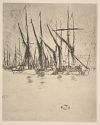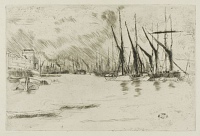Etchings Institutions search term: keppel
Pickle Herring Wharf | ||
| Number: | 164 | |
| Date: | 1876/1877 | |
| Medium: | etching and drypoint | |
| Size: | 152 x 229 mm | |
| Signed: | butterfly at lower right | |
| Inscribed: | no | |
| Set/Publication: | 'Cancelled Plates', 1879 | |
| No. of States: | 8 | |
| Known impressions: | 30 | |
| Catalogues: | K.167; M.163; W.137 | |
| Impressions taken from this plate (30) | ||
STATE
Seven states are known before cancellation.
State 2

Drypoint additions include five short horizontal lines at upper left and three patches of close drypoint horizontals in the sky, at left, upper centre and at right by the two rightmost masts; horizontal and curving horizontal drypoint lines below the stern of the nearest rowboat, with a short right-left diagonal line (/) echoing the slant of the stern; some other shading appears to be strengthened, but this may be the result of heavier inking.
State 3

More horizontal lines are added at upper left; several patches of fading drypoint in the sky and clouds are reinforced with strong curving drypoint lines; light shading is added to the reflections in the water.
State 4

The smoke from the steamers is denser; the shadows from the vessels at right are increased; both rowboats in front are shaded for their whole length; light diagonal drypoint lines are added behind the distant shipping and stronger lines augment and extend the shading in the sky, particularly above the taller masts in the centre and above the buildings at left.
State 5

Horizontal drypoint lines are added in the sky over and to right of the shipping at right, and diagonal lines above and behind the distant shipping.
State 6

The side of the barge to left of the two men in the rowboat is shaded with slanting lines; roughly slanting lines are added between the sails and masts of the shipping moored at right; the warehouse at far right is shaded with vertical lines.
State 7

The short horizontal lines which run toward the left from the high topmast, and some of the short slanting lines between the other masts, have been removed.
Kennedy only reproduces a detail, and the original impression has not been located. 8 It is possible that the drypoint was fading rather than being removed.
8: Kennedy 1910 (cat. no. 167).



